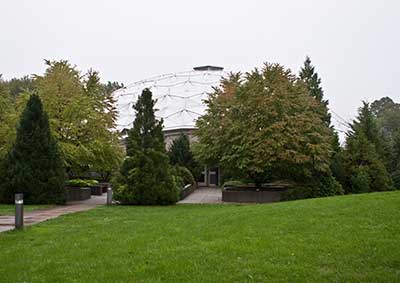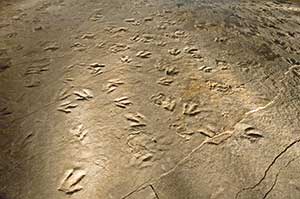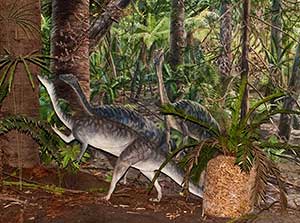
| Hours | Tue.-Sun.: 9:00 a.m. - 4:20 p.m. (trail closes at 4:00 p.m.)
Park closed on Thanksgiving day, Christmas day, and New Year's Day
|
| Admission |
Adults ages 13 and over: $6 Children ages 6-12: $2, Children ages 5 and under: Free |
| Address |
Dinosaur State Park 400 West Street Rocky Hill, CT 06067 USA |
Description
 |
| Dinosaur State Park Trackway. |
 |
| Dinosaur State Park Mural. |
The trackway contained beneath the dome has over 500 prints. It appears that these prints were made millions of years ago near a lake, shoreline or otherwise wet environment. The dinosaurs of the time existed in an unusual ecosystem with more carnivores than herbivores. Usually the reverse is true with fewer carnivores. The prints were probably laid around the Triassic-Jurassic extinction hence the lack of herbivores. It is somewhat unknown how the tracks were preserved. They must have been covered over by other sediments soon after the tracks were laid because no cracks are observed in the trackway. Had the tracks in the mud been left for several days, the mud would have dried and cracks would have appeared. This is not apparent in the trackway so we can conclude that they were covered and preserved soon after they were laid. This means the 500+ tracks were laid in a period of 24 hours or so, although it is possible the moisture was preserved for a longer period of time by an algae or similar compound on the surface. However, the real mystery is the swimmer tracks made from a dinosaur swimming in water high enough so that only the toes of the dinosaur scratched the surface. It is unknown how these were preserved. A water body of that size would have taken weeks perhaps months to dry enough so that the remaining tracks could be laid. It may have happened several months prior to the other tracks.
The first trackway containing six large footprints was found by Edward McCarthy on accident in 1966. McCarthy was not a professional but he was foresighted because he notified the paleontologists of the Peabody Museum and a few weeks later more discoveries were made and it was announced to be a State Park. One month later a smaller trackway with more footprints was found. This trackway is what we now see encased within the large dome.